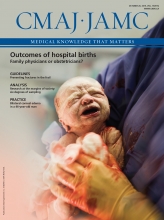Listen to CMAJ editors and authors discuss and comment on the content of this issue. Visit soundcloud.com/cmajpodcasts
Proper treatment for hepatitis C
The recent introduction of highly effective oral drug treatments for hepatitis C virus (HCV) infection has directed attention to the health impacts of HCV-related liver disease and engendered a push for treatment. People who inject drugs, both current and past users, make up the majority in the second wave of HCV infection. Although new treatments may be of benefit, we must not forget to address the associated health risks that result in dismal health outcomes for this group.

Costs of novel treatments for HCV are high but will be offset through prevention of late-stage complications of disease over the next two decades. Currently, restrictions dictate who can access the new, expensive treatments. The authors of this commentary call for the collection of prospective treatment data that capture real outcomes to help streamline clinical programming. See Commentaries, pages 1111 and 1113
Fralick and Feld provide a brief overview of recent advances in the diagnosis and management of HCV infection and describe a revised approach to screening that may replace current practice in Canada. See Five things to know about …, page 1159
Delivery outcomes: FP v. obstetrician

Whether babies were delivered by a family physician or an obstetrician made no difference to perinatal mortality or to maternal mortality and morbidity. This observational study analyzed administrative data for all hospital births in Canada (except Quebec) between April 2006 and March 2009, comprising nearly 800 000 babies and 800 000 mothers. Instrumental variable analysis was used to adjust for unmeasured potential confounders. See Research, page 1125
Heart rate linked to future frailty
Higher resting heart rate and lower heart rate variability were associated with worse functional status and with higher risk of future functional decline in older adults independent of cardiovascular disease. These findings come from a prospective study of 5042 adults aged 70 to 82 years at increased risk of heart disease. This study provides insight into the role of cardiac autonomic function in the development of functional decline, suggest the authors. See Research, page E442
Fracture prevention in long-term care
In older adults living in long-term care facilities, fractures cause pain, agitation, immobility and transfer to hospital. Based on systematic reviews of the evidence, this guideline provides recommendations to prevent fractures in this vulnerable group. Several strategies are addressed: vitamin D and calcium supplementation, use of hip protectors, exercise, multifactorial interventions to prevent falls and pharmacologic therapies. See Guidelines, page 1135
Researching hard-to-reach people
Health research involving people in marginalized populations can be challenging, and recruitment is often difficult. One approach, respondent-driven sampling, takes advantage of connections between people in these groups, who recruit each other in a chain-referral (friend of a friend) manner. See Analysis, page 1145
Acute diarrhea in HIV infection

A 65-year-old man with chronic HIV infection presents with a one-week history of diarrhea. Using this case scenario, Lam and Bunce discuss an approach to the diagnosis and management of acute diarrhea in patients with HIV. See Decisions, page 1153
Corneal edema with amantadine use

Bilateral corneal edema is a rare adverse effect of amantadine, a commonly prescribed neuropsychiatric drug. In this case, a 46-year-old man with progressive visual loss associated with amantadine use had improvement of his vision when the drug was stopped. Yang and colleagues caution that early identification and withdrawal of amantadine is essential to prevent irreversible damage. See Cases, page 1155












Podcast